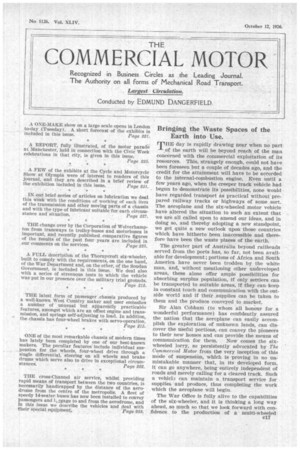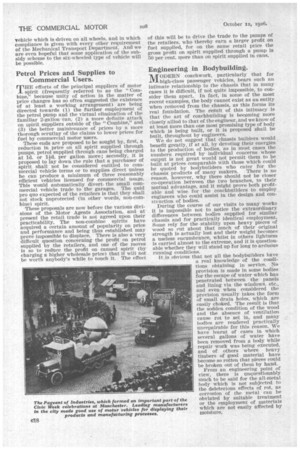Bringing the Waste Spaces of the Earth into Use.
Page 39

Page 40

If you've noticed an error in this article please click here to report it so we can fix it.
THE day is rapidly drawing near when no part of the earth will be beyond reach of the man concerned with the commercial exploitation of its resources. This, strangely enough, could not have been foreseen but a couple of decades ago, and the credit for the attainment will have to be accorded to the internal-combustion engine. Even until a few years ago, when the creeper track vehicle had begun to demonstrate its possibilities, none would have regarded transport as practical without prepared railway tracks or highways of some sort. The aeroplane and the six-wheeled motor vehicle have altered the situation to such an extent that we are all called upon to amend our ideas, and in doing so, and thereby adopting a new standpoint, we get quite a new outlook upon those countries which have hitherto been inaccessible and therefore have been the waste places of the earth.
The greater part of Australia beyond railheads served from the ports has, so far, not been available for development ; portions of Africa and South America have never been trodden by the white man, and, without mentioning other undeveloped areas, these alone offer ample possibilities for absorbing surplus population, if only settlers can be transported to suitable areas, it they can' keep in constant touch and communication with the outside world and if their, supplies can be taken to them and the produce conveyed to market.
Sir Alan Cobham (to whom all honour for a wonderful performance) has confidently assured the nation that the aeroplane can easily accomplish the exploration of unknown lands, can discover the useful portions, can convey the pioneers to their new homes and can provide the means of communication for them. Now comes the sixwheeled lorry, so persistently advocated by The Commercial Motor from the very inception of this mode of suspension, which is proving in no unmistakable manner that, in its developed form, it can go anywhere, being entirely independent of roads and merely calling for a cleared track. Such a vehicla can maintain a transport service for supplies and produce, thus completing the work which the aeroplane will begin.
The War Office is fully alive to the capabilities of the six-wheeler, and it is thinking a long way ahead, so much so that we look forward with confidence to the production of a multi-wheeled vehicle which is driven on all wheels, and in which compliance is given with every other requirement of the Mechanical Transport Department. And we are even hopeful that some application of the subsidy scheme to the six-wheeled type of vehicle will be possible.
Petrol Prices and Supplies to Commercial Users.
THE efforts of the principal suppliers of motor spirit (frequently referred to as the "CornMae," because unity of action in the matter of price changes has so often suggested the existence of at least a working arrangement) are being directed towards (1) the further employment of the petrol pump and the virtual elimination of the familiar 2-gallon can, (2) a more definite attack on spirit suppliers outside of the "Combine," and (3) the better maintenance of prices by a more thorough scrutiny of the claims to lower prices for fuel by commercial motor users.
These ends are proposed to be sought by, first, a reduction in price on all spirit supplied through pumps, petrol supplied through cans being charged at id. or 1t1. per gallon mare; secondly, it is proposed to lay down the rule that a purchaser of spirit shall not be considered entitled to commercial vehicle terms or to supplies direct unless he can produce a minimum of three reasonably efficient vehicles licensed for commercial usage. This would automatically divert, the small commercial vehicle trade to• the garages. The quid pro quo expected of the retailers is that they shall not stock unprotected (in other words, non-combine) spirit.
These proposals are now before the various divisions of the Motor Agents Association, and at present the retail trade is not agreed upon their practicability. The non-combine spirits have acquired a certain amount of popularity on price and performance and being thus established may prove impossible to displace. There is also a very difficult question concerning the profit on petrol supplied by the retailers, and one of the moves is so to reduce the profit on canned spirit (by charging a higher wholesale price) that it will not be worth anybody's while to touch it. The effect of this will be to drive the -trade to the pumps of the retailers, who thereby earn a larger profit on fuel supplied, for on the same retail price the gross profit on spirit supplied through a pump is 50 per cent. more than on spirit supplied in cans.
Engineering in Bodybuilding.
ATODERN coachwork, particularly that for -1-VJ.-high-class passenger vehicles, bears such an intimate relationship to the chassis that in many cases it is difficult, if not quite impossible, to consider them apart. In fact, in some of the most recent examples, the body cannot exist as an entity when rerhoved from the chassis, as this forms its real foundation. The reSult of this intimacy is that the art of coachbuilding is becoming more closely allied to that of the engineer, and we know of at least more than one most promising type of body which is being built, or it is proposed shall be built, throughout by engineers.
We do not suggest that chassis builders would benefit greatly, if at all, by devoting their energiesto the production of bodies, as in most cases the numbers required by individual concerns whose output is not great would not permit them to be Mint at prices comparable with those which could be quoted by bodybuilders who cater for the chassis products of many Makers. There is no reason, however, why there should not be closer co-operation between the two branches, to their mutual advantage, and it might prove both profitable and wise_ for the coachbnilders to employ engineers who could assist in the design and construction of bodies.
During the course of our visits to many works it is impossible not to notice the extraordinary differences between bodies supplied for similar chassis and for practically identical employment. Some rely for the-stability upon heavy pieces of wood so cut about that much of their original strength is actually lost and their weight becomes a useless encumbrance, whilst in others lightness is carried almost to the extreme, and it is questionable whether they will stand up for long to arduous running conditions.
It is obvious that not all the bodybuilders have a real knowledge of the ,conditions obtaining in service. No provision is made in some bodies for the escape of water which has penetrated between the panels and lining via the windows, etc., and even when considered the provision usually takes the form of small drain holes, which are easily choked. The result is that the sodden condition of the wood and the absence of ventilation cause rot to set in, and many bodies are rendered practically unrepairable for this reason. We have learnt of cases in which several gallons of water have been removed from a body while repair work was being executed, and of others where heavy timbers of good material have become so rotten that pieces could be broken out of them by hand.
From an engineering point of view, there is unquestionably much to be said for the all-metal body which is not subjected to the deleterious effects of rot, as corrosion of the metal can be obviated by suitable treatment or the employment of materials which are not easily affected by moisture.












































































































